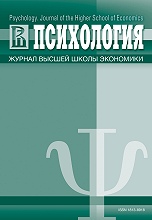Judgments of Learning for Words in Horizontal Space
Abstract
Judgments of learning are subjective estimations about the future retrieval of a recently learned piece of information. Judgments of learning might be based on valid cues, and therefore predictive of future performance or on invalid cues and not reliable. Knowing the variables that can affect judgments of learning is especially relevant in educational settings because they might influence the time spent learning new material. Embodied cognition research has shown that we have an internal numerical scale, in which lower numbers are represented on the left of a horizontal line and higher numbers on the right. Our aim was to investigate whether the spatial numerical distribution on the horizontal space is reflected on metacognitive judgements, specifically, on judgments of learning. Participants were presented with words located either on the left or on the right side of the screen. After each word and on a different screen they provided judgments of learning on a scale of 0 to 100 in deciles. After a distractor task, participants completed a recognition test. Results showed that horizontal location of the words did not affect judgments of learning nor the later recognition memory test. Our results support previous research on judgments of learning and spatial location, strengthening the conclusion that judgments of learning are a more deliberative process impervious to spatial numerical distribution.
Downloads
References
2. Cumming, G. (2012). Understanding the new statistics: Effect sizes, confidence intervals, and metaanalysis. New York: Routledge.
3. Dehaene, S., Bossini, S., & Giraux, P. (1993). The mental representation of parity and number magnitude. Journal of Experimental Psychology: General, 122, 371-396.
4. Fischer, M. H., & Roitmann, J. (2005). Do negative numbers have a place on the mental number line? Psychology Science, 47, 22-32.
5. Frith, C. D. (2012). The role of metacognition in human social interactions. Philosophical Transactions of the Royal Society B, 367, 2213-2223.
6. Ito, Y., & Hatta, T. (2004). Spatial structure of quantitative representation of numbers: Evidence from the SNARC effect. Memory and Cognition, 32, 662-673.
7. Koriat, A. (1997). Monitoring one’s own knowledge during study: A cue-utilization approach to judgments of learning. Journal of Experimental Psychology: General, 126, 349-370.
8. Li, P., Jia, X., Li, X., & Li, W. (2016). The effect of animacy on metamemory. Memory and Cognition, 44, 696-705.
9. LiveCode. (2015). LiveCode (Version 7.1)[Computer Software]. Edinburgh, UK: LiveCode.
10. Luna, K., MartRn-Luengo, B., Shtyrov, Y., & Myachykov, A. (2016). Judgments of learning for words in vertical space. Frontiers in Psychology, 7, 1894.
11. Macmillan, N. A., & Creelman, C. D. (2005). Detection theory. Mahwah, NJ: Erlbaum.
12. Meier, B. P., & Robinson, M. D. (2004). Why the sunny side is up: Associations between affect and vertical position. Psychological Science, 15, 243-247.
13. Meier, B. P., & Robinson, M. D. (2006). Does “feeling down” mean seeing down? Depressive symptoms and vertical selective attention. Journal of Research in Personality, 40, 451-461.
14. Meier, B. P., Hauser, D. J., Robinson, M. D., Friesen, C. K., & Schjeldahl, K. (2007). What’s “up” with God? Vertical space as a representation of the divine. Journal of Personality and Social Psychology, 93, 699-710.
15. Morey, R. D., & Rouder, J. N. (2015). BayesFactor: Computation of Bayes Factors for Common Designs. R Package Version 0.9.12-2. Retrieved from https://CRAN.R-project.org/package=BayesFactor
16. Nelson, T. O. (1990). Metamemory: A theoretical framework and new findings. In Psychology of learning and motivation (Vol. 26, pp. 125-173). San Diego, CA: Academic Press.
17. Pinhas, M., Shaki, S., & Fischer, M. H. (2014). Heed the signs: Operation signs have spatial associations. The Quarterly Journal of Experimental Psychology, 67, 1527-1540.
18. R Core Team. (2015). R: A Language and Environment for Statistical Computing. Vienna, Austria: R Foundation for Statistical Computing.
19. Rhodes, M. G., & Castel, A. D. (2008). Memory predictions are influenced by perceptual information: evidence for metacognitive illusions. Journal of Experimental Psychology: General, 137, 615-625.
20. Soares, A. P., Iriarte, A., Almeida, J. J., Simões, A., Costa, A., França, P., … Comesaña, M. (2014). Procura-PALavras (P-PAL): Uma nova medida de frequ Kncia lexical do PortuguKs Europeu contemporâneo [Procura-PALavras (P-PAL): A new measure of word frequency for contemporary European Portuguese]. Psicologia: Reflexăo e Cr9tica, 27, 1-14. Retrieved from http://ppal.di.uminho.pt (in Portugal)
21. Wagenmakers, E. J., Morey, R. D., & Lee, M. D. (2016). Bayesian benefits for the pragmatic researcher. Current Direction in Psychological Science, 25, 169-176.





